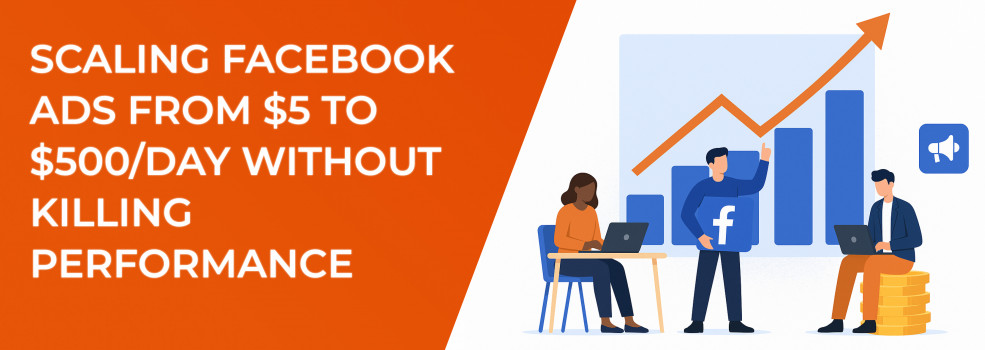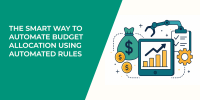Turning a tiny test budget into a revenue-generating machine is the holy grail of Facebook Ad Performance. Yet too many advertisers nudge their daily spend up, watch numbers nosedive, and decide scaling “just doesn’t work.” The truth? It does if you respect the algorithm, your audience, and your own data. Below is a step-by-step game plan to go from a modest $5 to $500 per day while keeping your ROAS Facebook Ads and other vital metrics healthy.
1. Lock In a Bulletproof Baseline
Before you even think about scaling, check that your current campaign is one worth pouring gas on. Imagine tuning up a race car before the big track day — you wouldn’t skip the tire-pressure check, right? The same mindset applies here.
Track the Right Metrics
Here are four guardrails you should watch like a hawk:
-
Good CTR on Facebook Ads — aim to beat your industry benchmark or at least the average click-through rate on Facebook Ads.
-
Facebook Ads Cost Per Result / CPA — know your break-even point so you can spot when costs creep too high.
-
Return on Ad Spend (ROAS) — a stable Facebook Ads Return on Ad Spend shows you can safely ramp spend.
-
Ad Impressions Facebook & Frequency — rising frequency without conversions signals creeping Facebook Ad Fatigue.
When you continuously monitor these, you’ll know exactly when your scaling moves start to erode efficiency, and you can correct course quickly.
Need to troubleshoot sudden delivery drops? Read Ad Set May Get Zero on Facebook — Why It Happens & How to Fix It before you pour more budget into a stalled campaign.
Fix Leaks First
Run a quick audit in Ads Manager. Patch slow-loading pages, clunky checkouts, and any funnel gaps. Scaling a leaky bucket just wastes money. After your fixes, double-check that your baseline metrics look even stronger; that tells you you’re ready for growth.
If clicks are coming in but revenue isn’t, this guide on Facebook Ads Not Converting: How to Fix It walks you through every funnel checkpoint.
2. Prepare Your Campaign for Growth
With a sturdy baseline in place, it’s time to set up the scaffolding that lets you climb higher without fear.
Nail Tracking and Attribution
Set up the Meta Pixel (or Conversions API) properly — “create pixel on Facebook” remains a must-do in 2025. Clean, consistent data keeps the algorithm smart when budgets jump. You might even bring server-side tracking into the mix for extra reliability.
Diversify Creative Early
Testing multiple creative styles early gives Meta more data — and you more control over scaling.
Rotate at least three concepts per ad set. Continuous Facebook Ad Creative Testing gives you fresh winners to swap in when performance plateaus. Remember: what hooks scrollers today can bore them next week.
For fresh ideas you can test tomorrow, check out the roundup of Best AI Text and Image Generators.
Tighten Audiences
Here’s a structure that scales gracefully:
-
Warm Pools — website traffic, engagers, and purchasers.
-
Lookalikes — 1–3% Lookalike Audiences Facebook built from highest-value customers.
-
Broad — interest plus behavior stacks for scale.
New to segmentation? Start with the fundamentals in Facebook Ad Targeting 101: How to Reach the Right Audience.
Layering these buckets cushions you if one audience saturates after budget increases. As you expand, revisit your segmentation monthly to keep things fresh. After these preparation steps, your account will feel like a finely tuned engine, ready for bigger fuel injections.
3. Choose Your Scaling Method
Now for the fun part: adding fuel.
Horizontal Scaling (Duplication)
Duplicate the best ad set three to five times, each with the same Facebook Ads Daily Budget. Tiny shifts in audience and auction dynamics help you find new pockets of scale without shocking any single ad set. Classic Horizontal Scaling Facebook Ads is especially useful when your original ad set is capped by frequency. A brief reflection here: horizontal scaling spreads risk, so even if one duplicate underperforms, others can pick up the slack.
Vertical Scaling (Budget Bumps)
For ad sets with steady results, increase Facebook Ad Budget by 10–20% every 48 hours. Larger jumps can push you back into Learning Limited Facebook Ads status, tanking performance. Stick to calculated, incremental moves.
Campaign Budget Optimization & Advantage+
Flip high-volume campaigns to Campaign Budget Optimization (CBO) or the newer Advantage Campaign Budget setting. Meta reallocates spend to the best-performing ad sets in real time, smoothing volatility as you rise toward $500 per day. Monitor results for at least three days before making further edits. Whichever method you pick, consistency and patience beat impulsive leaps every time.
You can dive deeper into settings and pitfalls in Scaling Facebook Campaigns with Advantage+ Budget Allocation.
4. Master the Meta Learning Phase
Every big change drops an ad set back into the Meta Learning Phase. Think of it as teaching the platform’s AI a new dance routine. Follow these ground rules:
-
Keep at least 50 conversions per week per ad set.
-
Avoid editing creatives or targeting while learning.
-
Combine tiny audiences so the system exits learning faster.
To exit learning faster, follow the tactics in How to Finish the Facebook Learning Phase Quickly.
If you do hit “Learning Limited,” consider pausing low-volume ad sets, raising budgets on strong ones, or merging similar ad sets into a single, healthier cohort. Mastering this phase keeps your performance from yo-yoing as you scale.
5. Automate Guardrails to Protect Performance
Your next move is building autopilot safeguards. No pilot flies without an altimeter; likewise, no media buyer should scale without automated rules.
Step-by-step instructions live in How to Use Automated Rules to Improve Facebook Campaign Efficiency.
-
Cost Per Result — pause if CPA rises 30% above baseline.
-
ROAS — scale up 20% when ROAS stays 20% above goal for three days.
-
Frequency — alert when Facebook Ad Frequency exceeds 3 in 7 days.
Automated rules protect your spend and let scaling happen without constant manual checks.
Implementing these rules lets you sleep soundly, knowing sudden spikes or dips won’t blindside your budget.
6. Refresh Creatives and Audiences on a Schedule
Stale ads kill momentum faster than any budget tweak. Here’s a cadence that keeps the algorithm happy and the audience curious:
-
New Creative Concepts every 2–3 weeks.
Spotting fatigue early is easier with the tips in Ad Fatigue on Facebook: How to Fix It Fast. -
New Audience Angles — fresh interests, new lookalikes, broader geos — every month.
-
Rotate copy hooks to fight Facebook Ad Fatigue while preserving proven structures.
Treat creative refreshes like oil changes: inexpensive, regular, and vital for longevity. After each refresh, watch your baseline metrics improve — proof that novelty still fuels attention.
7. Graduating to $500 Per Day and Beyond
By the time you’re spending $500 per day, you’ll notice new pain points: inventory limitations, comment moderation, and higher-stakes attribution errors. A proactive approach here pays dividends:
-
Upgrade to Meta Ads Conversion APIs for bulletproof tracking.
-
Explore predictive or AI-driven audience tools to sidestep saturating lookalikes.
-
Sync daily dashboards so you can react to dips before they snowball.
At this stage, scaling further is less about “how much can I spend” and more about maintaining margin while warding off fatigue.
Key Takeaways
-
Scale only what’s already profitable. Make sure your baseline is airtight.
-
Combine Horizontal and Vertical Scaling for smoother growth.
-
Respect the algorithm’s learning phase with measured edits to avoid roller-coaster results.
-
Automate guardrails so you can sleep and scale soundly.
Ready to push past the $500 per-day mark? Equip your toolkit with predictive audience builders, deeper conversion tracking, and disciplined reporting, and you’ll drive sustainable growth at any level.

